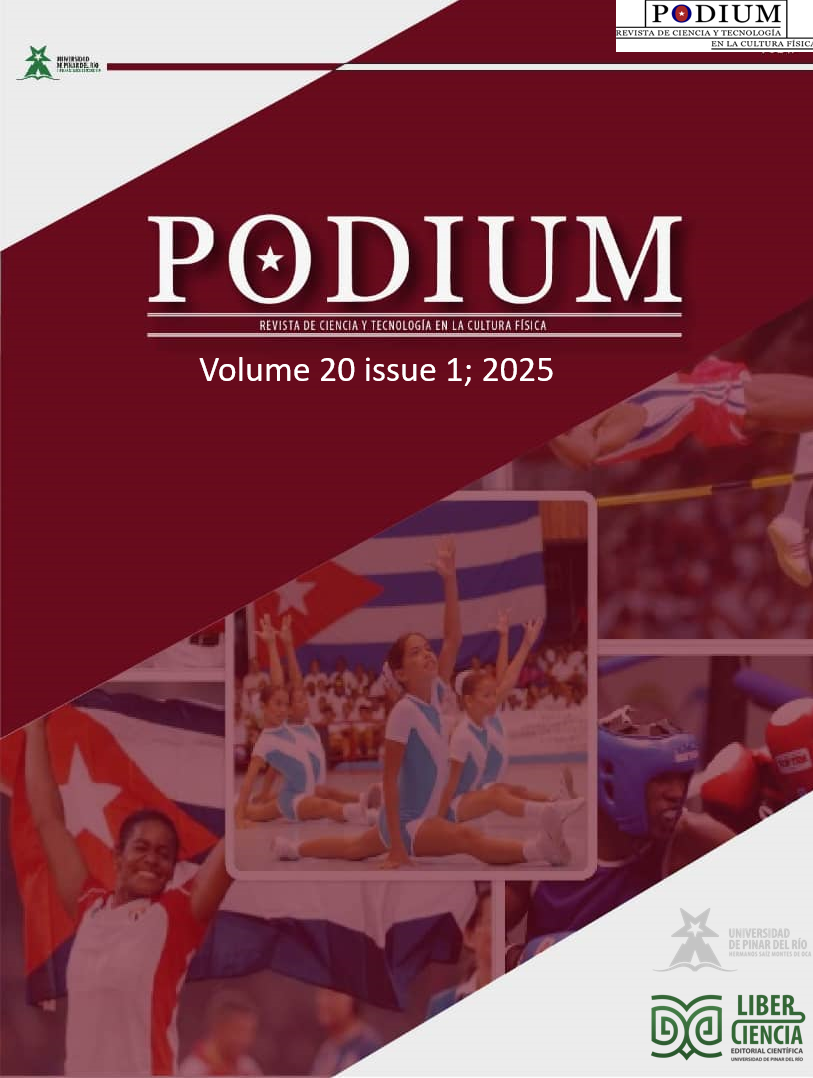Combat test to assess tactical performance in ne waza
Main Article Content
Abstract
The control and evaluation of the judoka's tactical preparation process continues to be an essential aspect for sports performance. Given the need to find new forms of control and evaluation from the demands of competitive activity, the purpose of this study was to develop a combat test to evaluate the tactical performance of the school judokas of the Isle of Youth. The main empirical methods used in the research were: direct and indirect scientific observation, measurement and modeling, and the filming technique was also used. It was evident that the defensive tactical action was a little superior to the offensive, but both are distinguished by their low effectiveness rate. The variability of offensive and defensive actions is considered positive. No penalties were recorded from the offensive and defensive function. The defensive tactical level was better than the offensive. Tactical performance was evaluated as fair in male and female. No differences were found between weight divisions and sex. Conclusions: tactical performance was characterized by a defensive tendency and low effectiveness of offensive and defensive actions in both sexes. The osae waza predominated as the main element to achieve victory and the kansetsu waza displaced the shime waza as the second option of preference in these ages. The offensive and defensive tactical activity were not enough, you lose more than you gain.
Downloads
Article Details

This work is licensed under a Creative Commons Attribution-NonCommercial 4.0 International License.
References
Agostinho, M. F. y Franchini, E. (2021). Observational analysis of the variability of actions in judo: the key for success? Revista de Artes Marciales Asiáticas, 15(2), 69-77. https://doi.org/10.18002/rama.v15i2.6341
Blach, W., Rydzik, L., Blach, L., Cynarski, W. J., Kostrzewa, M. y Ambro¿y, T. (2021). Characteristics of technical and tactical preparation of elite Judokas during the World Championships and Olympic Games. International Journal Environmental Research Public Health, 18, 5841. https://doi.org/10.3390/ijerph18115841
Delis M., E. (2019). Proceso de entrenamiento de la táctica en los judocas masculinos de la categoría 15-16. Revista Cultura Física y Deportes de Guantánamo, 9(Supl. 1). https://core.ac.uk/download/pdf/288194416.pdf
Espinosa M., M., Santana Lugones, J. L., y González Pascual, J. A. (2019). Exigencias del combate de judo para la etapa de iniciación del judoca. Conrado, 15(66), 54-58. http://conrado.ucf.edu.cu/index.php/conrado
Fernández F., R., y del Monte del Monte, L. (2022). Test para evaluar la representación mental de los conocimientos técnicos y dinámicos en las acciones deportivas preestablecidas en las poomsae del taekwondo. PODIUM, 17(3), 1208-1224. https://podium.upr.edu.cu/index.php/podium/article/view/1383
Galindo G., Y. E. y Enrique Muñiz, C. A. (2023). Sistema de acciones técnico-tácticas para el mejoramiento de los ataques combinados en el judo. Ciencia y Deporte, 8(2), 4161. https://cienciaydeporte.reduc.edu.cu/index.php/cienciaydeporte/article/view/60/28
González G., J. B. y Enrique Muñiz, C. A. (2023). Sistema de preparación técnico-táctica para mejorar la ejecución bilateral de los Tokui-Waza. Ciencia y Deporte, 8(3), e66. https://cienciaydeporte.reduc.edu.cu/index.php/cienciaydeporte/article/view/66/395
Gras-Consuegra, Manuel de J., Reyes Palau, N. C. y Samada Cruz, Y. (2021). Control técnico-táctico de combinaciones en el nague-waza del judo. Arrancada, 21(39), 125-135. https://dialnet.unirioja.es/servlet/articulo?codigo=9120045
Hernández Wimmer, C., Tamayo Contreras, V., Aedo Muñoz, E. y Rojas Reyes, C. (2021). Sistema de evaluación del desempeño técnico-táctico en voleibol, una propuesta sencilla. Retos, 39, 318-324. https://doi.org/10.47197/retos.v0i39.79301
Miarka, B., Valenzuela Pérez, D. I., Aedo-Muñoz, E., Fernandes da Costa, L. O., & Ciro Brito, J. (2020). Technical-tactical behaviors analysis of male and female judo cadets' combats. Frontiers in psychology, 11, 1389. https://doi.org/10.3389/fpsyg.2020.01389
Ramón Suárez, G., y Agudelo Velásquez, C. A. (2024). Análisis comparativo de tres combates de judo entre Shohei Ono y An Chang-Rim, usando el programa Judomatrix.GRS. VIREF Revista De Educación Física, 12(4), 3342. https://revistas.udea.edu.co/index.php/viref/article /view/356415
Sánchez Nodarse, I. (2012). Control y evaluación de la preparación táctica del karateca de alto rendimiento. `Combate test'. Lecturas: Educación Física y Deportes, 16(165), 1. https://www.efdeportes.com/efd165/preparacion-tactica-del-karateca.htm
Silva Batista, M. A., Sequeira, D., Gancho, H. y Fernandes, J. (2022). Predominance of techniques analysis used in the final rounds of judo international competitions scoring for the Olympic ranking: A biomechanical approach. Retos, 46, 833-842. https://recyt.fecyt.es/index.php/retos/article/view/94538
Soria Becquer, J., Pérez Cuesta, R. y Pérez Morales, D. (2023). Desempeño táctico de judokas escolares en el ne waza. PODIUM, 18(1). e1351. https://podium.upr.edu.cu/index.php/podium/article/view/1351
Stankovic, N., Nurkic, M., Cicovic, B. y Milosevic, N. (2019). The technical-tactical profile of the best judokas in the world in the middleweight category. Homo Sporticus Issue 2, 61-66. https://homosporticus.ba/wp-content/uploads/2020/05/for-print_11_21_2_HSporticus -Stankovic-Nurkic-Cicovic-Milosevic.pdf
Valencia Sánchez, W.G. (2021). Efecto de un programa de entrenamiento táctico en fútbol juvenil: caso único. E-balonmano.com, 17(1), 23-44. https://dialnet.unirioja.es/servlet/articulo?codigo=7834328
Vizcay Medina, C., Ramos Quian, Y., Olivares Acosta, P., y Quiñones Rodríguez, Y. (2022). Test para evaluar la rapidez específica en porteras de balonmano de la preselección nacional cubana. PODIUM, 17(3), 1067- 1978. https://podium.upr.edu.cu/index.php/podium/article/view/1192


